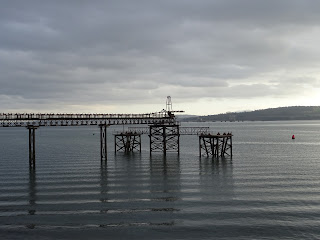Sometimes when I’m out walking, I end up wandering through the desolate, post demolition sites of old factories and industrial complexes. These places always have a sort of apocalyptical feel about them with the traces of what was once there being consumed by nature. In a way I suppose they are like the landscapes in some sci-fi drama set after a devastating nuclear conflict or alien invasion. There is a sort of eerie emptiness to them. They feel slightly lawless and forgotten. The site of Caldwell’s Paper Mill in Inverkeithing is a bit like that with the scrub growing through the remains of concrete floors that seem to stretch on for miles. Crumbling concrete that is being swallowed back into the earth beneath it. While wandering around the place I sometimes feel like I’ve drifted into another dimension where humanity has collapsed and society ceased, but rather than bumping into some Mad Max types or some trundling Daleks, I’m usually met by some curious dog bounding through the scrub to bark loudly at me, try to get me to throw its ball, or maybe just attempt to sniff my crotch before being called back by its apologetic owner.
Caldwell’s Paper Mill was built in 1914 for
Caldwell & Co. Papermakers Ltd. At
the time it was built the mill had four paper machines. It was bought over by Inveresk in 1928 who added
a fifth paper machine. They ran the
company until 2002 when it was purchased by the Scandinavian firm Klippan. About
a year after the takeover the mill was closed with the loss of 160 jobs. The mill then lay derelict until August 2012
when it was demolished.
After a bit of a jaunt around the site I
ended up back at the partial remains of one of the buildings. There I left the Skulferatu that had
accompanied me on my walk, in a pipe hole in the wall of the building. As I
walked away, the glass from the thousands of smashed beer bottles covering the
ground nearby, glittered and sparkled in the early afternoon sunlight.
The coordinates for the location of the
Skulferatu are –
Latitude 56.028555
Longitude -3.3968700
I used the following sources for
information on Caldwell’s Paper Mill -
Canmore - Caldwell's
Mill, Inverkeithing
Daily Record, Monday 13
August 2012
For anyone who is interested there is a rather good video by John Davis of the chimneys of the old mill being demolished in a controlled explosion. I've included the link here –
Demolition of Caldwell paper mill in Inverkeithing
.jpg)
.jpg)
.JPG)
.jpg)
.jpg)
.jpg)
.jpg)
.jpg)
.JPG)
.JPG)
.JPG)
.JPG)
.JPG)
.JPG)
.jpg)
.jpg)
.jpg)
.JPG)
.jpg)



















